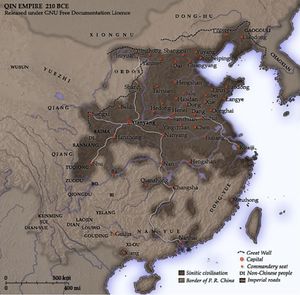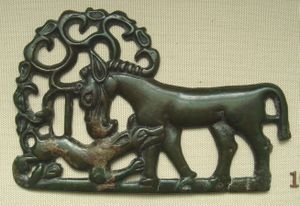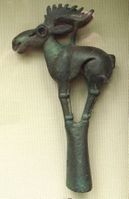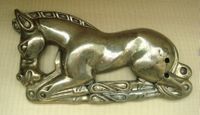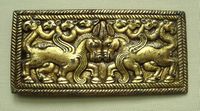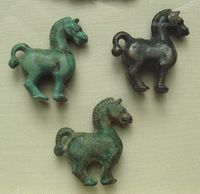ثقافة أوردوس
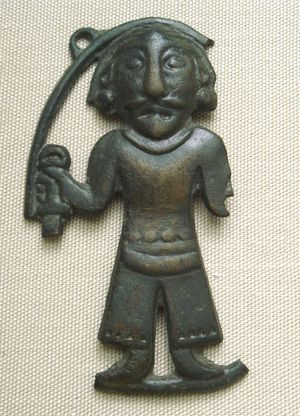
ثقافة أردس أو أوردوس Ordos culture كانت ثقافة تحتل منطقة تتمركز حول ثنية أوردوس (منغوليا الداخلية الحالية، الصين) أثناء العصرين البرونزي والحديدي المبكر من القرن السادس حتى الثاني ق.م.. ثقافة أُردُس اشتهرت بلـُقى بارزة من الفن السكوذي ويُعتقد أنها تمثل أقصى امتداد إلى الشرق للرحل الأوراسيين الهندو-أوروپيين، مثل شعب الساكا.[2][3][4] وفي عهد أسرتي چين وهان، من القرن السادس إلى الثاني ق.م.، كانت المنطقة تحت السيطرة، على الأقل اسمياً، للدول الصينية المعاصرة.
خلفية
الرحل الأوروپيون من الشمال الغربي احتلوا المنطقة التي كانت في السابق مستقـَر ثقافة ژوكايگو من القرن السادس إلى القرن الثاني ق.م. قبل أن تطردها شيونگنو.[5] وكانت هضبة أوردوس مغطاة بالحشائش والأجمات والأشجار وكانت ترويها بكفاية أنهار وغدران عديدة لتنتج مراعي غنية.[6] في ذلك الوقت، كانت تضم أفضل أراضي كلأ في السهوب الآسيوية.[7] إلا أن معظمها تحول الآن إلى صحراء أردس عبر توليفة من الرعي الجائر و التغير المناخي.[بحاجة لمصدر]
السمات
الأردس عـُرِفوا أساساً من بقايا هياكلمهم العظمية ولقاهم. وثقافة أردس من حوالي 500 ق.م. إلى 100م عـُرِفت بسبب "برونزيات أردس"، الأسلحة النصلية، finials for tent-poles, horse gear, and small plaques and fittings for clothes and horse harness, using animal style decoration with relationships both with the الفن السكوذي of regions much further west, and also Chinese art. Its relationship with the Xiongnu is controversial; for some scholars they are the same and for others different.[8] Many buried metal artefacts have emerged on the surface of the land as a result of the progressive desertification of the region.[9]
The Ordos are thought to be the easternmost of the Iranian peoples of the Eurasian Steppe, just to the east of the better-known Yuezhi, also an Indo-European people.[3][4] Because the people represented in archaeological finds tend to display Europoid features, also earlier noted by Otto J. Maenchen-Helfen,[1] Iaroslav Lebedynsky suggests the Ordos culture had "a Scythian affinity".[10][11] Other scholars have associated it with the Yuezhi.[6] The weapons found in tombs throughout the steppes of the Ordos are very close to those of the Scythians and Saka.[6][12]
الاتصال بالشعوب المجاورة
While the ethnolinguistic origins and character of the Ordos culture are unknown, the population appears to have been significantly influenced by Indo-European cultures.[3] However, the art of the Ordos culture appears to have influenced that of the Donghu people (الصينية: 東胡), a Mongolic-speaking nomadic tribe located to the east, suggesting that the two had close ties.[13] (The Donghu may also have been connected to a people known as the Northern Di in Chinese annals.
Han–Xiongnu War began with Emperor Wu of Han, and the Han colonized the area of the Ordos as the commandery of Shuofang in 127 BCE. Prior to this campaign, there were already earlier commanderies established by Qin and Zhao before they were overrun by the Xiongnu in 209 BCE.[14]
ظهور شيونگنو
في السجلات الصينية، ظـَهـَرت شيونگنو لأول مرة في أردس في يي ژو شو و كلاسيكية الجبال والبحار في فترة الدويلات المتناحرة قبل أن تحتلها دويلتا چين و ژاو. ويُعتقد عموماً أنها موطنهم؛ إلا أنه من غير المعروف على وجه الدقة متى جاءوا ليحتلوا المنطقة، وتقترح اللقى الأثرية أنهم ربما كانوا هناك قبل وقت طويل مما يُعتقد تقليدياً.[15]
وبينما كان الشيونگنو يتوسعون جنوباً إلى أراضي يوىژي حوالي سنة 160 ق.م. بقيادة مـُدون، فإن يوىژي بدورهم هزموا الساكا وطردوهم في إيسيك كول. ويُعتقد أن الشيونگنو احتلوا أيضاً منطقة الأردس في نفس الفترة، حين أصبحوا على اتصال مباشر مع الصينيين. ومن هناك، قام الشيونگنو بالعديد من الغارات المدمرة على الأراضي الصينية (في سنوات 167، 158، 142، 129 ق.م.).[16]
حرب الهان-الشيونگنو بدأت في عهد الامبراطور وو من هان، واستعمر الصينيون منطقة أردس بقيادة شووفانگ في 127 ق.م.. قبل تلك الحملة، كانت توجد بالفعل قيادات سابقة أسستها دويلتا چين و ژاو قبل أن يطردهم الشيونگنو في 209 ق.م.[17]
اللقى
برونزيات أوردوس من المتحف البريطاني (المعرض الآسيوي):
المراجع
الهامش
- ^ أ ب Maenchen-Helfen 1973, pp. 369–375
- ^ Lebedynsky 2007, p. 131
- ^ أ ب ت Macmillan Education 2016, p. 369 "From that time until the HAN dynasty the Ordos steppe was the home of semi-nomadic Indo-European peoples whose culture can be regarded as an eastern province of a vast Eurasian continuum of Scytho-Siberian cultures."
- ^ أ ب Harmatta 1992, p. 348: "From the first millennium b.c., we have abundant historical, archaeological and linguistic sources for the location of the territory inhabited by the Iranian peoples. In this period the territory of the northern Iranians, they being equestrian nomads, extended over the whole zone of the steppes and the wooded steppes and even the semi-deserts from the Great Hungarian Plain to the Ordos in northern China."
- ^ Bunker 2002, p. 26-29
- ^ أ ب ت Hanks & Linduff 2009, pp. 284–286
- ^ Beckwith 2009, p. 71
- ^ Compare this and this account, both from the 1970s. Bunker, 200, sees them as the same, or rather the Ordos people as a subgroup of the Xiongnu.
- ^ Bunker 2002, p. 200
- ^ Lebedynsky 2007, p. 125 "Europoid faces in some depictions of the Ordos, which should be attributed to a Scythian affinity"
- ^ Lebedynsky 2007, p. 125 "The Mongoloid types of the Transbaikal area and Central and Eastern Mongolia are strongly contrasted with the Europoid type displayed at the same time by the Scythian nomads occupying Western Mongolia and their predecessors of the Bronze age."
- ^ Lebedynsky 2007, p. 127
- ^ Lebedynsky, p.124
- ^ Ma 2005, p. 224
- ^ Ma 2005, p. 220-225
- ^ Lebedymsky p131
- ^ Ma 2005, p. 224
المصادر
- Beckwith, Christopher I. (16 March 2009). Empires of the Silk Road: A History of Central Eurasia from the Bronze Age to the Present. Princeton University Press. ISBN 1400829941. Retrieved February 18, 2015.
{{cite book}}: Invalid|ref=harv(help) - Bunker, Emma C. (2002). Nomadic art of the eastern Eurasian steppes: the Eugene V. Thaw and other New York collections (fully available online). New York: The Metropolitan Museum of Art. ISBN 9780300096880.
{{cite book}}: Invalid|ref=harv(help) - Hanks, Brian K.; Linduff, Katheryn M. (August 30, 2009). Social Complexity in Prehistoric Eurasia: Monuments, Metals and Mobility. Cambridge University Press. ISBN 0521517125. Retrieved March 13, 2015.
{{cite book}}: Invalid|ref=harv(help) - Harmatta, János (1992). "The Emergence of the Indo-Iranians: The Indo-Iranian Languages". In Dani, A. H.; Masson, V. M. (eds.). History of Civilizations of Central Asia: The Dawn of Civilization: Earliest Times to 700 B. C. (PDF). UNESCO. pp. 346–370. ISBN 978-92-3-102719-2. Retrieved 29 May 2015.
{{cite book}}: Invalid|ref=harv(help) - Lebedynsky, Yaroslav (2007). Les nomades. Éditions Errance. ISBN 9782877723466.
{{cite book}}: Invalid|ref=harv(help) - Macmillan Education (2016). Macmillan Dictionary of Archaeology. Macmillan International Higher Education. ISBN 1349075892.
{{cite book}}: Invalid|ref=harv(help) - Maenschen-Helfen, Otto (1973). The World of the Huns: Studies in Their History and Culture. University of California Press. ISBN 0520015967. Retrieved February 18, 2015.
{{cite book}}: Invalid|ref=harv(help) - Ma, Liqing (2005). The Original Xiongnu, An Archaeological Exploration of the Xiongnu's History and Culture. Hohhot: Inner Mongolia University Press. ISBN 7-81074-796-7.
وصلات خارجية
- The Relief Plaques of Eastern Eurasia and China - The Ordos Bronzes - video by Sir John Boardman, 3m 47 sec
